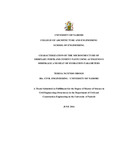| dc.contributor.author | Mbogo, Teresa N | |
| dc.date.accessioned | 2016-11-15T06:35:54Z | |
| dc.date.available | 2016-11-15T06:35:54Z | |
| dc.date.issued | 2016 | |
| dc.identifier.uri | http://hdl.handle.net/11295/97197 | |
| dc.description.abstract | The main objective of this study was to characterize the microstructure of
Ordinary Portland Cement paste using autogenous shrinkage and heat of
hydration parameters. The relevance of the research was the need to advance
the knowledge on understanding the underlying mechanism of autogenous
shrinkage and heat of hydration parameters and their influence on the
evolution of cement paste microstructure. This will allow Engineers to
develop performance based specifications to mitigate pre mature cracking due
to autogenous shrinkage and heat of hydration.
Though there are many types of cements manufactured and available in
Kenya, this thesis focused on Ordinary Portland Cement paste. To limit scope
and hence achieve a comprehensive research, the research was limited to
cement paste and concrete mixes of water/cement (w/c) ratios of 0.35 and
0.45. Type K temperature probes and Extech Differential Temperature Data
Logger were used to measure the heat of hydration of Ordinary Portland
Cement paste. Strain gauge and MadgeTech Bridge/Strain data loggers were
used to measure autogenous shrinkage-induced strain of hydrating Ordinary
Portland Cement paste. A stereo microscope was used to evaluate the
microstructure evolution of a hydrating Ordinary Portland Cement paste (as a
function of pores formation and cracking).
The research findings were that samples with lower w/c ratios recorded higher
autogenous shrinkage, bigger pores and increased risk of cracking than the rest
of the samples. It was also found that curing in saturated conditions ensures
replacement and availability of more water for hydration of Ordinary Portland
Cement paste. This reduces autogenous shrinkage. Availability of water for
curing reduces the temperature due to cooling aided by the presence of water.
It was recommended that further research is done to relate the development of
pore structure with autogenous shrinkage. The effect of aggregates on
autogenous shrinkage should be further studied. Evidence that autogenous
shrinkage causes problems in concrete practice in this region should be sought. | en_US |
| dc.language.iso | en | en_US |
| dc.publisher | University of Nairobi | en_US |
| dc.rights | Attribution-NonCommercial-NoDerivs 3.0 United States | * |
| dc.rights.uri | http://creativecommons.org/licenses/by-nc-nd/3.0/us/ | * |
| dc.subject | Characterization of the Microstructure | en_US |
| dc.title | Characterization of the Microstructure of Ordinary Portland Cement Paste Using Autogenous Shrinkage and Heat of Hydration Parameters | en_US |
| dc.type | Thesis | en_US |



